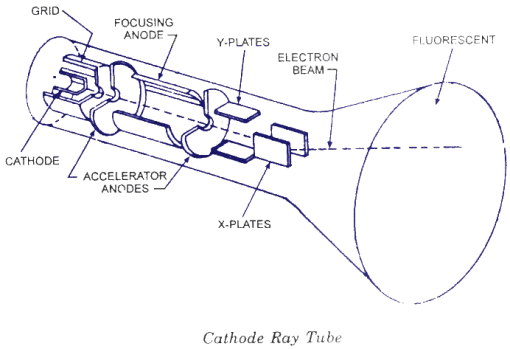Cathode Ray Tube (CRT)
A CRT is an electronic tube designed to display electrical data.
The basic CRT consists of four major components.
- Electron Gun
- Focussing & Accelerating Anodes
- Horizontal & Vertical Deflection Plates
- Evacuated Glass Envelope

1. Electron Gun
It is used for producing a strain of electrons
2. Focussing & Accelerating Anodes
These are used for producing a narrow and sharply focus beam of electrons.
3. Horizontal and Vertical Deflection Plates
These are used for controlling the path of the beam.
4. Evacuated Glass Envelope
With a phosphorecent screen which produces bright spot when struct by a high velocity electron beam.
The electron gun assembly consists of an indirectly heated cathode (K), a control grid (G), an accelerated anode A1, focussing anode A2 and accelerating anode A3
Working of CRT
Heater element is energized by alternating current to obtain high emission of electron from cathode. Control grid is bised negative with respect to cathode it controls the density of electron beam to focus the electron beam on the screen focusing anode is used. the focusing anode opperate at a potential of twelve hundred (1200 V) and accelerating anode at 2000 V to accelerate the electron beam.
Two pairs of deflection plates provided in the CRT these deflection plates are mounted at right angle to each other to provide electron beam deflection along vertical and horizontal axis of the screen. The screen consists of a glass which is coated by some florescent material lie zinc silicate. Which is semitransparant phosphor substance. When high velocity electron beam structs the phosphorescent screen the light emitts from it. The property of phosphor to emitt light when its atoms are excited is called fluorescence.
Applications of CRT
- In cathode ray socilloscope
- As a display device in radar
- In televisions
- In computer Monitors
